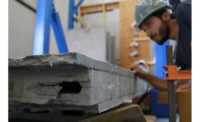Researchers in Northern Ireland report promising results from a demonstration project that used rods made with basalt fibers to reinforce a 22-meter-long concrete-deck section of a $1.5-million replacement bridge in County Fermanagh. The mineral material, which resists corrosion and has twice the tensile strength of steel, is not yet accredited for structural use in the U.K.
In addition to testing the basalt-fiber-reinforced polymer (BFRP), the project is a demonstration of compressive membrane analysis in deck design, says Susan Taylor, a senior structural-engineering lecturer at Queen’s University, Belfast, which secured a $160,000 grant from the U.K. Dept. for Transport for the demonstration. The method takes into account the arching behavior within restrained slabs, which enhances load capacity beyond that predicted using conventional flexural theory, she says.
Taylor champions the deck design method to enhance sustainability by improving concrete durability and making more efficient use of materials. Although compressive membrane design analysis was accepted by U.K. regulators eight years ago, “a lot of consultants are only using [it] for assessments of [existing bridges] while using conventional methods for new designs,” Taylor says.
For the demo, Taylor directed the Thompson’s Bridge structural engineer, AECOM Ltd., Glasgow, to design the middle two-thirds of the bridge span using compressive membrane action and self-compacting concrete, obviating the need for vibrators. The section was built with basalt rebar, while the 5-m-long ends of the deck were conventionally reinforced and designed.
The 10.9-m-wide deck was cast in place over four longitudinal, precast-concrete, flat-bottomed U-shaped beams. The 16-centimeter-thick deck typically spans 1.6 m between the beams.
After the bridge’s structural completion in August, Taylor’s team tested the deck by applying a simulated wheel load up to 40 tonnes—nearly three times the European Union’s maximum vehicle axle load, Taylor says.
Subcontractor Sengenia Ltd., Belfast, monitored the test by fitting strain gauges to sets of both the BFRP and the steel rebar, using fiber Bragg grating written on optical cables. The firm’s founder, Simon Grattan, claims the optical cable technique is better than using more cumbersome metal wires still common in the U.K.
Taylor says the tests recorded maximum strains of the BFRP rebar as “very, very low,” at 11.7% of the maximum capacity. The BFRP-reinforced deck deflected around 0.8 millimeters, which was less than half the deflection recorded on the equivalent steel-reinforced section. But because of other variables in the concrete, Taylor says she is reluctant to claim that BFRP reinforced sections demonstrated much better performance than the steel samples, beyond saying the BFRP section of deck “was behaving well under service loads and was slightly better” than steel.
Members of the team, working for the project’s design-build contractor McLaughlin & Harvey Ltd., Mallusk, Northern Ireland, say they saw little difference between detailing the areas with either BFRP or steel bars. One drawback, however, is the inability to bend BFRP bars on-site. “It’s got to be ordered in … shape,” says one designer.
The material is sourced from a manufacturer in Cheboksary, Chuvash Republic, Russia, which constrained the researchers’ ability to make last-minute detailing changes.
BFRP has twice the tensile strength—at about 1,200 megapascals—of steel, while weighing 75% less and is more resistant to the alkali concrete environment than glass fiber, says Ben Williams, managing director of the start-up supplier MagmaTech Ltd., London, which supplied the “RockBar” reinforcing rods for the project. He says the cost of BFRP rebar is similar to that of glass fiber, 30% to 40% cheaper than stainless steel and roughly three times more expensive than common steel rebar.
In construction, wall ties fabricated with the material have been used as an alternative to stainless steel when low thermal conductivity is required, but Williams says the Thompson’s Bridge project is the first significant structural use of BFRP rebar. He calls the project “a great step forward.”
Williams is targeting high-corrosion-risk projects in which repairs would be difficult. In these conditions, BFRP would be less costly than stainless steel and, he claims, perform better than a glass-fiber product.
BFRP production is “very simple,” Williams adds. Unlike glass, he says, “Basalt is mined, melted and extruded into fibers with no purification steps or additives.”
The bridge’s owner, the Northern Ireland Road Service, says it’s interested in BFRP’s potential to eliminate bridge corrosion; at a more mundane level, they say, it’s pleasing to get most of their bridge’s rebar paid for by the Queens researchers.
Using BFRP rebar in U.S. highways “will take some time,” believes Mohsen Issa, professor of Structural and Materials Engineering at the University of Illinois at Chicago. His department has tested beams reinforced with the material and he is talking with various agencies about its possible use. “We are working with the industry to try using BFRP in a pilot project like a concrete slab or a bridge deck,” he adds. “The industry is very excited about the BFRP rebar due to its strength and durability properties.”







Post a comment to this article
Report Abusive Comment